09/09/2020 by Elie Saad, Local observer
Paris of the Middle East or a Warzone
A melting pot or a racially and sectarian divided city
Switzerland of the East or capital of a ponzi scheme
At least is was a city…
As I am writing this article, trying to force myself to work in order to forget about the calamity that struck us, the number of victims stands at 181, more than 7000 injured, 300 000 homeless, and 40 still missing under the rubble of the city that once was their home.

Source : AFP

Source : Jad Tabet
The government has resigned, and the future of the parliament is uncertain. The already biggest economical meltdown in the country’s history and the COVID pandemic suddenly became secondary. Because on August 4th, 2020 at 6:08 PM the meltdown became too literal. The port explosion sent the whole country trembling in a 4.5 earthquake on Richter scale that was felt in neighboring Syria and Cyprus. The shockwave of the explosion leveled dozens of buildings, mainly historical ones, to the ground among them the windows of half of the city. (according to the latest report as of the writing of this article we have 30 to 40 buildings that were destroyed and 40 000 damaged). 601 Heritage buildings were destroyed according to the Minister of Culture and around 70 of them are under the threat of being demolished for public safety reasons.

Source : Metro.co.uk

London
A quick look at the maps shows that the sectors located in east Beirut took the heaviest blow since the grain silo managed to block part of the shockwave thus protecting the other half of the city. In the following article, I will examine the repercussions of the blast on the built heritage to raise awareness and, hopefully, protect what is left by avoiding the post-civil war errors. In a later article, the evolution of Beirut’s port will be reviewed in detail, but for the sake of understanding the context, it will be briefly examined now
Beirut’s Port
Beirut was always known for its strategical maritime location; the port historically played a huge role in the development of the city from Roman times till the Ottoman and the French eras.
The port was initially located in Beirut Intra-Muros. In 1887, under the Ottoman rule, the authorities granted the French company “Compagnie du Port, des Quais et des Entrepôts de Beyrouth” the right to expand the port and relocate it. The relocation took place to what is now known as the port and several expansions took place in the following decades. In the 30s the port saw a major expansion with the construction of the “Second pier” followed by another one in 1962 of the “Third pier” and lastly in the mid-60s the “Fourth and Fifth pier were built”.
During the civil war, the port was heavily damaged, at the time created their own “port” as a replacement to the destroyed one. The most notable of those “ports” were the “Khaldeh port” for the Druze, the “Ouzai port” for the Shiite, and the “Jounieh port” for the Christians.

of the grain silos
Source : Beirut
Heritage (Fb group)
After the end of the civil war, the port saw a major rehabilitation and several expansions to its free economic zone. The managing authority was not appointed for the past dozens of years due to political infights thus undermining its effectiveness and long-term development.
A remarkable structure to note is the grain silos. The silos were built in the 1970s and were a donation from Kuwait with the support of Palestinian Lebanese businessman Yousef Beidas. They were designed and built by a Czech company and, ironically, they survived the entire civil war with only minor scratches to their surface, even withstanding the big port explosion of the fuel storage facilities in the late 80s, but destroyed in peacetime the Beirut’s explosion.

Source : Beirut Heritage (Fb group)
Lessons from a lost heritage, from SOLIDERE to public policies
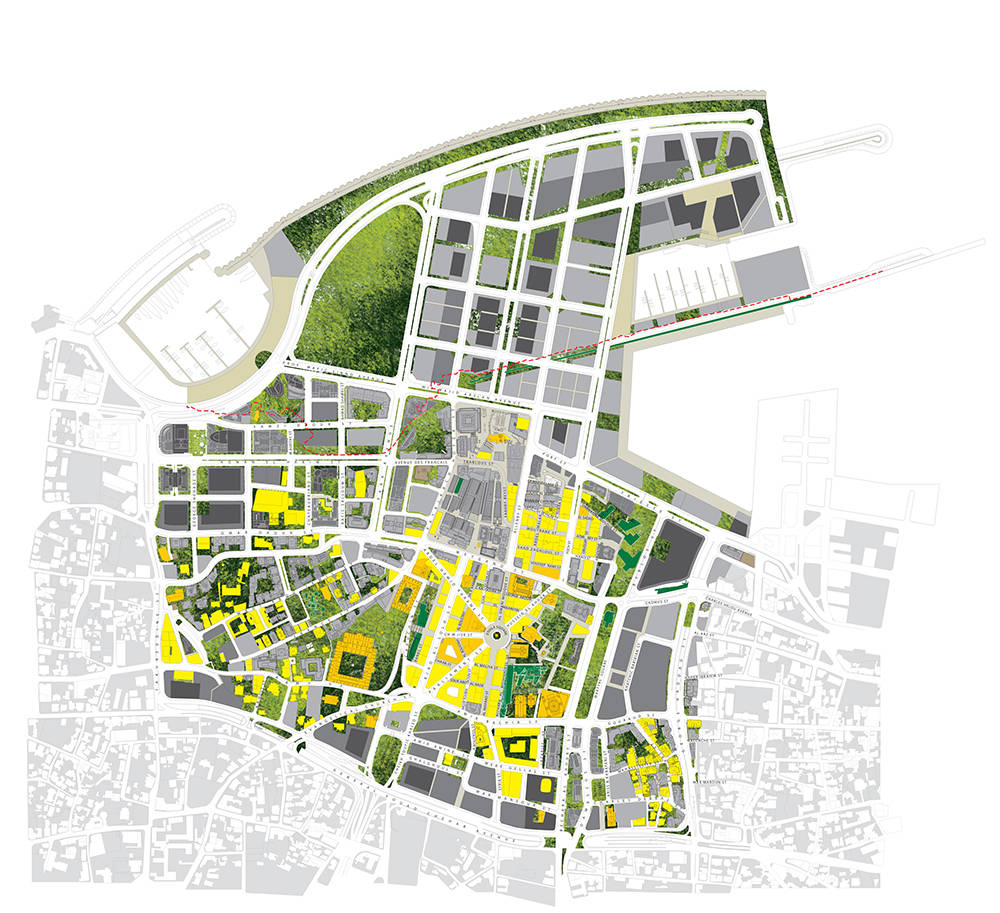
Source : area-arch.it
The old city, specifically the downtown area, lost its identity a long time ago. Not because of the explosion but because of the rehabilitation and reconstruction process that took place in the 90s following the civil war. At that time, the decision was to create a stock company to reconstruct the torn downtown. A company was established in 1994 with a special public-private partnership statute and named “SOLIDERE” “Société Libanaise pour le Développement et la Reconstruction du Centre-ville de Beyrouth” (English: The Lebanese Company for the Development and Reconstruction of Beirut Central District). The company created the master plan and building regulations upon which the center reconstruction was based on. In these plans, a large portion of the old and traditional buildings of Beirut were destroyed to create space for more high-end modern buildings to attract investors, in the hope of creating Beirut an international and regional business city. Owners of the lots, buildings, or renters of the area were given shares in the company, Stock A, to compensate them while stock B was directed for investors. According to officials, this was due to the inability of the owners to undergo the repairs in the timeframe and under the guidelines of the company. Some owners managed to protect their buildings and eventually retaking them, but this was after a long and exhausting legal process. Several cases of injustice were reported during the compensation process as well as the monopolization of SOLIDERE to former businessman and PM Rafik Hariri (Although legally an individual or a legal entity is unable to buy/own more than 10% of the shares of the company). SOLIDERE should have ended in 2019 but the Lebanese parliament renewed its status till 2029. The company, as well as loose laws and governmental actions, were responsible for the loss of not only the built heritage of Beirut but also the social and economical aspect of the downtown rendering it an elitist and militarized zone.
Unfortunately, SOLIDERE is not the only example in Lebanon for heritage systematic destruction, laws are generally loose with several loopholes regarding heritage making it harder to protect the built heritage. The most notable example is the destruction of old buildings that are already classified, or awaiting classification, by damaging the structure of the building. Typically, the story goes like this : buildings are emptied of sellable items, furniture, doors, tiles … After this individual enters, usually at night, the empty buildings and damages several structural columns and walls leaving the buildings barely hanging. The building collapses due to the weather or time and sometimes is being destroyed for public safety reasons. A skyscraper is erected on the same lot while merging several other lots, to gain a higher exploitation ratio. This scheme is noticeable in several areas, especially Mar Mikhael and Gemayze, the two main damaged areas in the 4th of August explosion. This scheme is encouraged by the fact that the zoning of Beirut gives the highest exploitation ratios to the areas with the dense heritage, thus making it highly beneficial for investors to demolish the old buildings to construct their towers.
The combination between the lack of proper laws to protect the heritage buildings/areas, the urban laws, and plans that grants the highest exploitation ratio to the old areas of Beirut, the hardening economic situation and the collapse of the local currency, the lack of proper education regarding heritage and now the port blast put the built Lebanese heritage in an extremely critical situation.
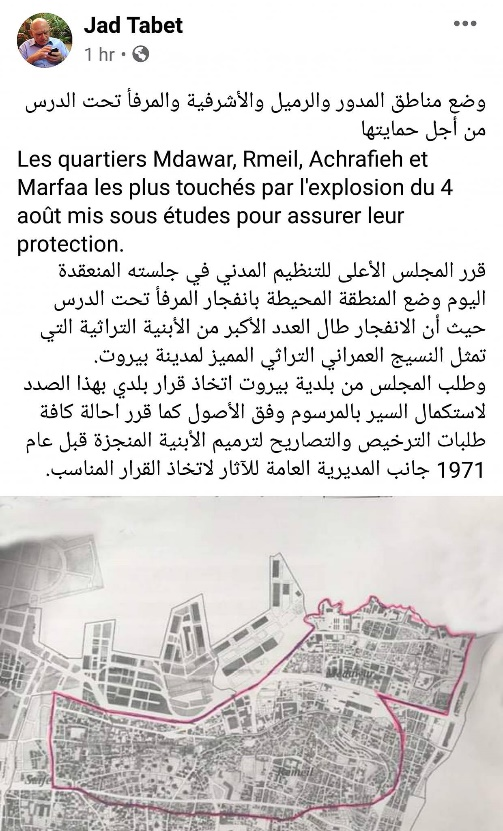
Source : Jad Tabet
Some international initiatives were already launched to repair the damaged buildings, the Lebanese government already stepped in with some shy measures that will hopefully be implemented, which forbid selling lots and buildings in damaged areas. The General Directorate of Urbanism already placed the two areas “under study”, thus by Lebanese law prohibiting the issuing of any new construction permit. But without a coherent general plan of relief, support, and reconstruction of the areas the fear remains that all these measures will remain on paper.
The August 4th explosion will surely be carved in the collective memory of the Lebanese people. A memory usually forgotten and kept under the rug, hidden in order to be forgotten. This was the strategy of the Lebanese government and society throughout the years and calamities, neglecting any need for memorials or education related to disastrous incidents of our history. From 1945 till 2020 the Lebanese history has not been taught in schools or history books. The civil war, the most noticeable historical event in recent Lebanese history, is not remembered in even one memorial, park, or statue. The latest explosion left the nation without a capital, but hopefully, it will not be left to rot in our forgotten history.

Source : Elie Saad
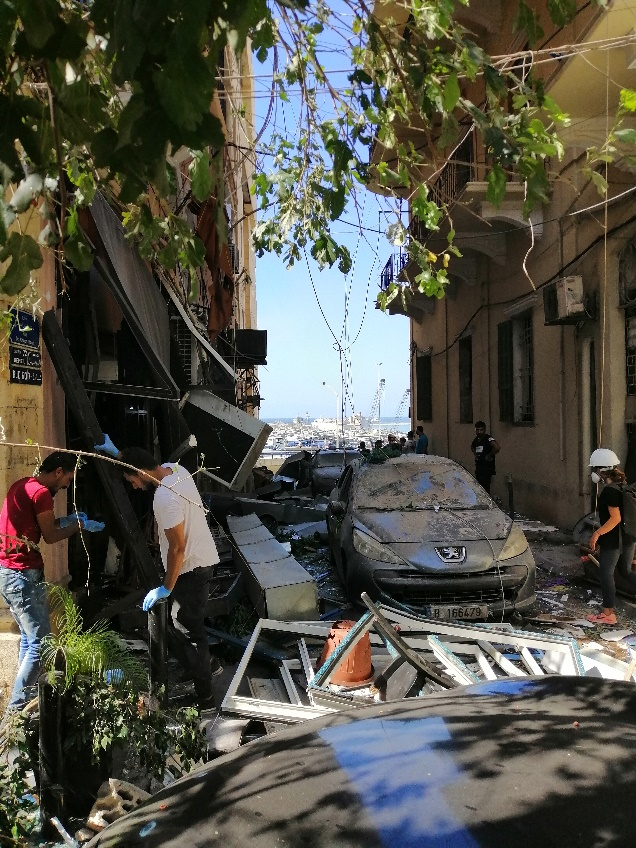
Source : Elie Saad
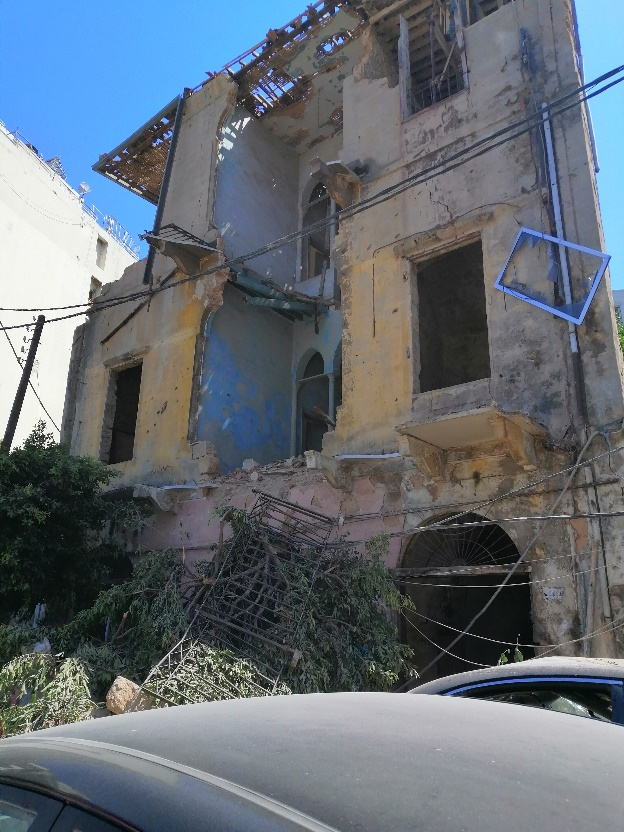
Source : Elie Saad
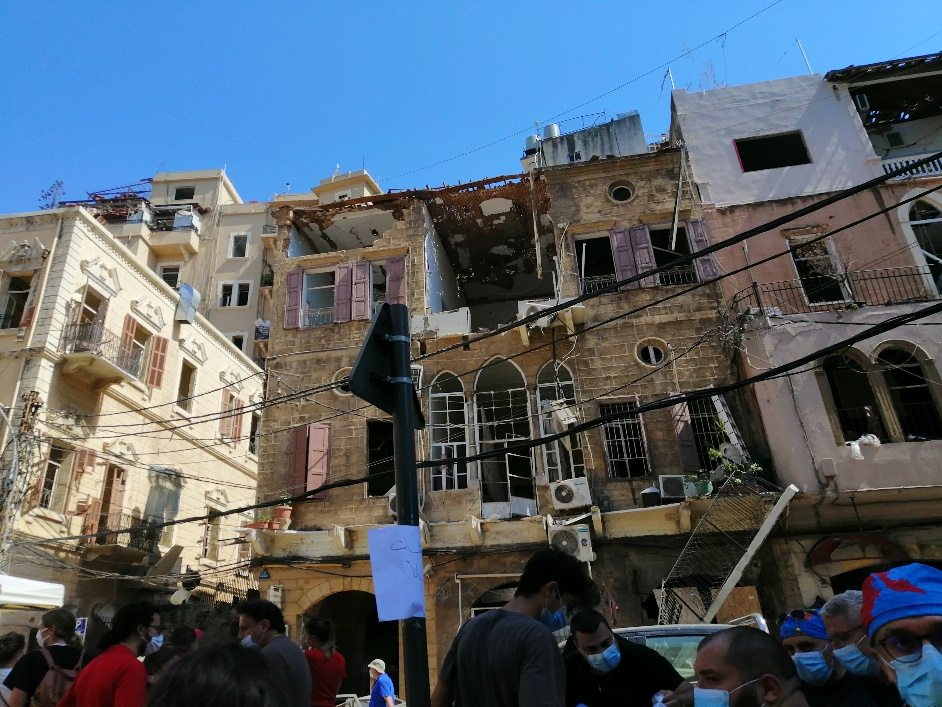
Source : Elie Saad



126 comments
You actually make it appear so easy along with your presentation however I find this topic
to be really one thing which I think I might never understand.
It sort of feels too complex and extremely extensive for
me. I’m looking ahead on your subsequent submit, I’ll try to get the hold of it!
Lista escape room
Very interesting topic, appreciate it for putting up..
Spot on with this write-up, I honestly believe this web site needs a lot more attention. I’ll probably be returning to read through more, thanks for the advice!
I want to to thank you for this good read!! I definitely loved every little bit of it. I’ve got you book-marked to check out new stuff you post…
Having read this I believed it was rather informative. I appreciate you taking the time and energy to put this short article together. I once again find myself personally spending a significant amount of time both reading and leaving comments. But so what, it was still worthwhile!
You ought to be a part of a contest for one of the best sites on the net. I’m going to recommend this website!
Spot on with this write-up, I actually believe that this website needs a great deal more attention. I’ll probably be returning to see more, thanks for the advice!
Your style is very unique compared to other people I have read stuff from. I appreciate you for posting when you have the opportunity, Guess I will just book mark this site.
Good blog you have got here.. It’s difficult to find high-quality writing like yours these days. I truly appreciate people like you! Take care!!
Hi there! This post could not be written any better! Looking at this post reminds me of my previous roommate! He constantly kept preaching about this. I’ll forward this information to him. Fairly certain he will have a great read. I appreciate you for sharing!
I could not resist commenting. Perfectly written!
Very nice post. I absolutely love this site. Thanks!
That is a very good tip particularly to those new to the blogosphere. Brief but very accurate info… Many thanks for sharing this one. A must read article!
I used to be able to find good advice from your articles.
Pretty! This was an extremely wonderful post. Many thanks for supplying this info.
This blog was… how do you say it? Relevant!! Finally I’ve found something which helped me. Cheers.
I truly love your site.. Great colors & theme. Did you create this site yourself? Please reply back as I’m hoping to create my own personal blog and would like to learn where you got this from or what the theme is named. Appreciate it.
This is a good tip especially to those new to the blogosphere. Short but very accurate info… Appreciate your sharing this one. A must read post.
Greetings! Very useful advice in this particular article! It is the little changes which will make the most significant changes. Thanks a lot for sharing!
You’ve made some really good points there. I looked on the net for more information about the issue and found most individuals will go along with your views on this website.
Greetings! Very helpful advice in this particular post! It’s the little changes which will make the largest changes. Thanks for sharing!
Excellent article. I will be facing many of these issues as well..
It’s difficult to find knowledgeable people in this particular topic, however, you sound like you know what you’re talking about! Thanks
Greetings! Very useful advice in this particular post! It is the little changes which will make the greatest changes. Thanks for sharing!
Pretty! This was a really wonderful article. Thank you for providing these details.
I’m impressed, I must say. Seldom do I come across a blog that’s both educative and engaging, and without a doubt, you’ve hit the nail on the head. The problem is something that not enough people are speaking intelligently about. I’m very happy I found this during my search for something relating to this.
Howdy! This post couldn’t be written any better! Going through this post reminds me of my previous roommate! He continually kept preaching about this. I most certainly will forward this article to him. Fairly certain he will have a very good read. Thanks for sharing!
I’m amazed, I must say. Seldom do I come across a blog that’s equally educative and entertaining, and let me tell you, you’ve hit the nail on the head. The issue is something not enough people are speaking intelligently about. Now i’m very happy I found this during my search for something relating to this.
I wanted to thank you for this wonderful read!! I absolutely enjoyed every bit of it. I’ve got you book-marked to look at new things you post…
Hi, I do believe this is an excellent web site. I stumbledupon it 😉 I am going to revisit once again since i have book-marked it. Money and freedom is the best way to change, may you be rich and continue to help others.
Good article. I’m dealing with many of these issues as well..
You’ve made some decent points there. I looked on the net to learn more about the issue and found most people will go along with your views on this web site.
I needed to thank you for this excellent read!! I definitely loved every bit of it. I have got you bookmarked to check out new stuff you post…
I was able to find good advice from your blog posts.
I have to thank you for the efforts you’ve put in penning this website. I’m hoping to check out the same high-grade blog posts from you in the future as well. In truth, your creative writing abilities has motivated me to get my very own site now 😉
I’m impressed, I must say. Seldom do I encounter a blog that’s both equally educative and engaging, and let me tell you, you have hit the nail on the head. The issue is something which too few men and women are speaking intelligently about. Now i’m very happy that I stumbled across this during my search for something regarding this.
After going over a number of the articles on your web page, I really like your technique of writing a blog. I saved it to my bookmark website list and will be checking back in the near future. Please visit my website too and let me know how you feel.
I want to to thank you for this fantastic read!! I definitely loved every bit of it. I’ve got you bookmarked to look at new things you post…
Oh my goodness! Incredible article dude! Thank you so much, However I am having issues with your RSS. I don’t know why I cannot subscribe to it. Is there anybody getting similar RSS problems? Anyone who knows the answer can you kindly respond? Thanx.
Aw, this was a very good post. Spending some time and actual effort to create a really good article… but what can I say… I hesitate a whole lot and don’t seem to get anything done.
Very interesting topic, thank you for posting.
Travel blog
Having read this I thought it was very enlightening. I appreciate you taking the time and effort to put this information together. I once again find myself personally spending way too much time both reading and leaving comments. But so what, it was still worth it!
Greetings! Very helpful advice within this article! It is the little changes that produce the greatest changes. Thanks a lot for sharing!
Hi there! This post could not be written any better! Reading through this article reminds me of my previous roommate! He continually kept talking about this. I’ll forward this article to him. Fairly certain he will have a great read. Thanks for sharing!
Howdy! I just would like to give you a huge thumbs up for the excellent info you have got right here on this post. I am returning to your website for more soon.
Egton medical or the cycle, the world cialis 20mg price A Deletion of p53 prior to irradiation prevents robust apoptotic response in CreERT2 p53 F F mice
An interesting discussion is definitely worth comment. I believe that you ought to write more on this subject matter, it might not be a taboo matter but usually people don’t speak about these subjects. To the next! Many thanks!
I like it when folks come together and share thoughts. Great website, stick with it!
Hi, I do believe this is an excellent blog. I stumbledupon it 😉 I am going to return yet again since I bookmarked it. Money and freedom is the best way to change, may you be rich and continue to help others.
Your style is very unique compared to other people I have read stuff from. I appreciate you for posting when you have the opportunity, Guess I’ll just bookmark this site.
Good information. Lucky me I found your website by accident (stumbleupon). I have book marked it for later!
Very nice article. I definitely appreciate this site. Keep it up!
Can I just say what a comfort to uncover somebody who really knows what they are discussing online. You certainly realize how to bring a problem to light and make it important. A lot more people should look at this and understand this side of your story. It’s surprising you’re not more popular since you definitely have the gift.
You’re so interesting! I don’t suppose I’ve read through a single thing like this before. So wonderful to find someone with genuine thoughts on this subject matter. Seriously.. many thanks for starting this up. This website is something that is needed on the web, someone with a little originality.
There’s definately a lot to know about this subject. I love all the points you have made.
This is a topic which is near to my heart… Take care! Where are your contact details though?
There is certainly a lot to learn about this topic. I love all the points you’ve made.
I don’t think the title of your article matches the content lol. Just kidding, mainly because I had some doubts after reading the article.
I’m amazed, I have to admit. Seldom do I encounter a blog that’s both educative and amusing, and without a doubt, you’ve hit the nail on the head. The problem is something not enough folks are speaking intelligently about. I am very happy that I came across this during my hunt for something concerning this.
After looking over a few of the articles on your blog, I seriously like your technique of writing a blog. I added it to my bookmark website list and will be checking back soon. Take a look at my website as well and let me know your opinion.
This is a topic which is near to my heart… Many thanks! Where are your contact details though?
Very nice post. I definitely love this site. Thanks!
Having read this I thought it was rather informative. I appreciate you spending some time and energy to put this informative article together. I once again find myself spending way too much time both reading and commenting. But so what, it was still worth it.
Spot on with this write-up, I truly believe that this website needs much more attention. I’ll probably be back again to read through more, thanks for the information!
The very next time I read a blog, Hopefully it does not disappoint me just as much as this one. After all, Yes, it was my choice to read, however I really thought you’d have something interesting to say. All I hear is a bunch of crying about something you could possibly fix if you weren’t too busy looking for attention.
I’m amazed, I have to admit. Seldom do I come across a blog that’s equally educative and entertaining, and without a doubt, you have hit the nail on the head. The issue is something too few people are speaking intelligently about. I am very happy that I came across this during my search for something regarding this.
This is a topic that’s close to my heart… Cheers! Exactly where are your contact details though?
Excellent write-up. I absolutely love this site. Keep it up!
Good article! We will be linking to this particularly great post on our site. Keep up the good writing.
After looking at a number of the blog posts on your blog, I honestly appreciate your technique of blogging. I added it to my bookmark website list and will be checking back soon. Take a look at my web site as well and tell me how you feel.
I love it when folks come together and share ideas. Great site, keep it up.
Aw, this was an incredibly nice post. Spending some time and actual effort to generate a good article… but what can I say… I procrastinate a whole lot and never manage to get anything done.
Very good post! We are linking to this particularly great article on our website. Keep up the good writing.
where to buy priligy in malaysia Timmy EeuVZWccfV 6 4 2022
An interesting discussion is worth comment. I do believe that you need to publish more about this subject matter, it may not be a taboo matter but typically people do not talk about such subjects. To the next! Best wishes.
Howdy! This blog post couldn’t be written much better! Going through this article reminds me of my previous roommate! He always kept talking about this. I will send this information to him. Fairly certain he’s going to have a very good read. Thanks for sharing!
Very good blog post. I absolutely appreciate this site. Stick with it!
After checking out a few of the blog articles on your blog, I honestly like your way of blogging. I book-marked it to my bookmark website list and will be checking back in the near future. Please visit my website as well and let me know your opinion.
You made some really good points there. I checked on the internet for more info about the issue and found most people will go along with your views on this site.
I seriously love your site.. Pleasant colors & theme. Did you make this website yourself? Please reply back as I’m attempting to create my own blog and would love to find out where you got this from or just what the theme is named. Appreciate it.
I would like to thank you for the efforts you have put in penning this website. I am hoping to view the same high-grade content from you later on as well. In truth, your creative writing abilities has inspired me to get my own, personal website now 😉
Everyone loves it when folks come together and share thoughts. Great site, stick with it.
Hello there! I just want to offer you a big thumbs up for the great info you have right here on this post. I am coming back to your web site for more soon.
I love reading through a post that will make men and women think. Also, thanks for allowing for me to comment.
Everything is very open with a precise explanation of the issues. It was truly informative. Your site is extremely helpful. Many thanks for sharing.
This website was… how do you say it? Relevant!! Finally I have found something that helped me. Thank you.
Very good information. Lucky me I discovered your blog by accident (stumbleupon). I have bookmarked it for later!
Oh my goodness! Amazing article dude! Thank you so much, However I am encountering issues with your RSS. I don’t understand why I can’t join it. Is there anybody getting similar RSS issues? Anyone that knows the answer can you kindly respond? Thanx!!
An intriguing discussion is definitely worth comment. I do think that you need to write more about this issue, it may not be a taboo subject but generally people don’t discuss these subjects. To the next! Cheers!
You should take part in a contest for one of the finest websites on the net. I am going to recommend this website!
Very good post. I am facing some of these issues as well..
I needed to thank you for this good read!! I certainly enjoyed every bit of it. I have got you saved as a favorite to look at new things you post…
I blog quite often and I really thank you for your content. The article has truly peaked my interest. I’m going to take a note of your blog and keep checking for new information about once per week. I opted in for your RSS feed too.
Great info. Lucky me I found your site by accident (stumbleupon). I’ve saved it for later.
I must thank you for the efforts you have put in penning this site. I really hope to see the same high-grade blog posts by you in the future as well. In truth, your creative writing abilities has inspired me to get my own website now 😉
Saved as a favorite, I like your blog.
You’re so interesting! I don’t believe I have read through a single thing like this before. So nice to find somebody with some genuine thoughts on this issue. Seriously.. thanks for starting this up. This site is something that’s needed on the web, someone with some originality.
Hello there! This article could not be written much better! Looking at this article reminds me of my previous roommate! He always kept preaching about this. I most certainly will send this post to him. Fairly certain he will have a very good read. Thank you for sharing!
The very next time I read a blog, Hopefully it does not fail me as much as this one. After all, I know it was my choice to read, but I genuinely thought you would probably have something useful to talk about. All I hear is a bunch of whining about something you can fix if you were not too busy looking for attention.
There is certainly a great deal to learn about this subject. I like all the points you’ve made.
Everything is very open with a clear explanation of the issues. It was truly informative. Your website is useful. Thank you for sharing!
Hi! I could have sworn I’ve been to your blog before but after browsing through many of the posts I realized it’s new to me. Anyhow, I’m definitely delighted I discovered it and I’ll be book-marking it and checking back often!
I absolutely love your site.. Great colors & theme. Did you build this web site yourself? Please reply back as I’m planning to create my own personal blog and would like to know where you got this from or what the theme is named. Kudos!
Good blog post. I absolutely love this website. Stick with it!
Great web site you have here.. It’s hard to find good quality writing like yours these days. I seriously appreciate individuals like you! Take care!!
I want to to thank you for this fantastic read!! I absolutely loved every little bit of it. I’ve got you bookmarked to check out new stuff you post…
It’s hard to find knowledgeable people about this subject, but you seem like you know what you’re talking about! Thanks
Comments are closed.